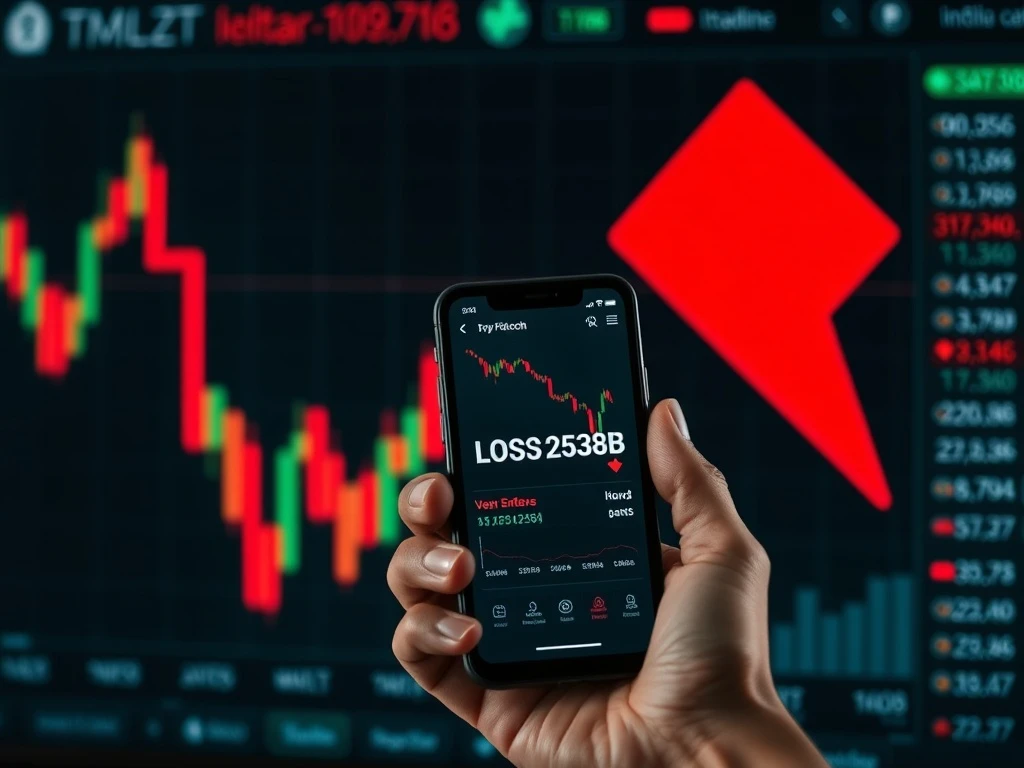PUMP Token: Devastating $700K Loss Rocks Crypto Market After Airdrop Announcement

The cryptocurrency world is no stranger to dramatic swings, but a recent incident involving a **PUMP token** holder serves as a stark reminder of the inherent volatility and the critical impact of founder statements. Imagine losing a staggering $700,000 almost overnight – that’s precisely what happened to one large investor, highlighting the precarious nature of even institutional-grade crypto trading and the profound influence of project founders. This event underscores why understanding **crypto market volatility** is paramount for every participant.
The PUMP Token Price Plunge: Unpacking the $700K Loss
On July 23, 2025, the crypto community watched as a significant event unfolded: a single **PUMP token** holder incurred a massive $700,000 loss. This devastating blow was the direct result of a mass sell-off involving 3.75 billion tokens on Coinbase Prime, triggered by a pivotal announcement from the project’s co-founder, Alon. The tokens, initially valued at $14.3 million, saw their price plummet by 20%—from $0.0039 to $0.0031—shortly after Alon clarified that there would be no near-term **airdrop announcement** for the token. This sudden price collapse, exacerbated by the substantial sell order, effectively erased nearly half the value of the investor’s position.
This incident is a textbook example of how quickly fortunes can shift in the digital asset space. The transaction, executed through Coinbase Prime—a platform designed for institutional-scale trades—highlighted the critical risks associated with timing and information asymmetry. While such platforms offer deep liquidity and advanced tools, the presale holder’s decision to offload tokens unfortunately coincided with the negative sentiment generated by the co-founder’s disclosure. Blockchain analytics firm @EmberCN noted that even large institutional trades remain highly vulnerable to sudden market shifts, especially when critical project updates are released.
Navigating Crypto Market Volatility: The Founder’s Influence
One of the defining characteristics of the cryptocurrency landscape, contributing significantly to **crypto market volatility**, is the profound influence of project founders and key figures. Unlike traditional financial markets, where corporate statements are often filtered through extensive regulatory scrutiny and official channels, crypto projects frequently rely on direct communications from their leaders, often via social media or community forums. This direct line of communication, while fostering community engagement, can also create immense price swings when expectations are unmet or unforeseen news breaks.
In the PUMP token’s case, the absence of an airdrop—a feature often anticipated to boost token value and reward early adopters—prompted immediate and intense sell pressure. Many investors speculate on future airdrops as a potential source of profit or increased token utility, making an official denial a significant bearish signal. For an asset with a small price per token, even a seemingly modest 20% drop can translate into colossal losses for large holders, demonstrating the amplified risk when dealing with highly leveraged or concentrated positions in volatile assets.
Institutional Crypto Trading: Lessons from Liquidity and Slippage
The PUMP token saga also sheds light on the challenges inherent in **institutional crypto trading**, particularly concerning liquidity and slippage. While Coinbase Prime is engineered to handle large-volume transactions, the rapid sell-off of 3.75 billion tokens coincided with a noticeable lack of buyer interest. This imbalance between supply and demand led to significant slippage, meaning the executed price for the sell order was considerably lower than the price observed just before the transaction.
Slippage is a common phenomenon in volatile or less-established tokens, where market depth—the total volume of buy and sell orders at different price levels—is insufficient to absorb sudden, large trades without causing substantial price depreciation. Even sophisticated platforms cannot magically conjure buyers when sentiment turns sour or when an unexpected **airdrop announcement** reversal hits the market. This incident serves as a stark reminder that even with advanced trading tools, the underlying market dynamics of liquidity can dictate the success or failure of a large trade.
Mitigating Presale Investment Risks: Strategies for Prudent Investors
This event brings to the forefront critical questions about risk management practices, especially for those involved in presale investments. Participants in early-stage token sales often face heightened **presale investment risks** due to inherent illiquidity, a strong reliance on project narratives, and often, a lack of established market history. The PUMP token holder’s strategy—to liquidate a massive position in one go—failed to adequately account for the timing of project-related news, a critical oversight in markets where sentiment can shift overnight.
Analysts consistently emphasize the importance of diversification and adaptive trading strategies in such dynamic environments. Here are some actionable insights:
- Scaling In and Out: Instead of executing one-time large trades, consider breaking down large positions into smaller, staggered orders. This can mitigate risks from sudden market movements and allow for better average entry/exit prices.
- Stop-Loss Mechanisms: Implementing automatic stop-loss orders can limit potential losses by selling an asset once it reaches a predetermined price.
- Hedging Strategies: For sophisticated investors, using options or futures to hedge against adverse price movements can offer a layer of protection, particularly against founder announcements or liquidity shocks.
- Due Diligence on Project Communications: Pay close attention to official channels and the credibility of project founders. Understand how their statements can impact token price.
- Liquidity Assessment: Before making large investments, especially in smaller cap tokens, assess the token’s market depth and trading volume to understand potential slippage risks.
The Future of Crypto Market Dynamics: Balancing Technology with Foresight
The PUMP token case aligns perfectly with broader trends observed in the crypto space, where rapid price swings are driven by a complex interplay of fundamental updates, technical analysis, and social media-driven sentiment. It serves as a powerful reminder that even institutional-grade platforms and advanced trading tools cannot insulate investors from the consequences of poor timing or unforeseen project developments. The inherent **crypto market volatility** means that every decision carries significant weight.
As the sector continues to mature, participants must learn to balance the technological advantages offered by blockchain and advanced trading platforms with behavioral and strategic foresight. This means not only understanding the technical aspects of cryptocurrencies but also anticipating market reactions to news, managing emotional responses, and implementing robust risk management protocols. The PUMP token incident is a harsh but valuable lesson in the ongoing evolution of the digital asset economy.
Conclusion
The $700,000 loss suffered by a **PUMP token** holder due to an unexpected **airdrop announcement** reversal vividly illustrates the profound impact of founder statements and liquidity dynamics on **crypto market volatility**. This event underscores that even sophisticated **institutional crypto trading** platforms cannot negate the **presale investment risks** associated with concentrated positions and poor timing. Investors must prioritize robust risk management strategies, including diversification, scaled trading, and vigilant monitoring of project communications, to navigate the unpredictable currents of the digital asset landscape successfully. The lesson is clear: in crypto, foresight and disciplined strategy are as crucial as the technology itself.
Frequently Asked Questions (FAQs)
Q1: What caused the PUMP token holder’s $700,000 loss?
The loss was primarily triggered by a mass sell-off of 3.75 billion PUMP tokens on Coinbase Prime, which occurred immediately after a co-founder announced there would be no near-term airdrop for the token. This news led to a 20% price drop, causing the significant loss for the large holder.
Q2: How did the airdrop announcement impact the PUMP token’s price?
The co-founder’s clarification that there would be no near-term airdrop directly contradicted market expectations, which often factor in potential airdrops as a value driver. This negative news prompted immediate sell pressure, leading to a rapid 20% decline in the token’s price from $0.0039 to $0.0031.
Q3: Why are founder statements so impactful in the crypto market?
Unlike traditional markets with extensive regulatory oversight, crypto projects often rely on direct communication from key figures. These direct statements can instantly shape market sentiment and expectations, leading to significant price volatility when announcements (like an airdrop denial) do not align with investor hopes.
Q4: What role did Coinbase Prime play in this incident?
Coinbase Prime is an institutional trading platform designed for large-volume transactions. While it offers deep liquidity, the PUMP token holder’s massive sell order coincided with negative news and a lack of buyer interest, leading to significant slippage and exacerbating the loss, demonstrating that even advanced platforms can’t prevent losses in illiquid conditions.
Q5: What lessons can investors learn about managing presale investment risks from this event?
Investors should prioritize diversification, avoid single large trades by scaling in/out of positions, utilize stop-loss mechanisms, and consider hedging strategies. Crucially, they must conduct thorough due diligence on project communications and understand how founder statements can profoundly affect token value and liquidity.








